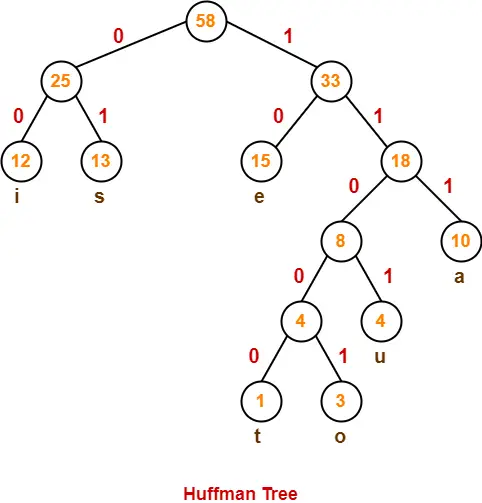
Return index - 1 def characteristics_huffman_code(self, code): There are a couple of functions defined inside the class which will be explained in the section below.
Given a word build huffman code tree code#
This is done to generate code as done by the tree traversal.

Once the Huffman codes are generated, read them in the reverse order to obtain the final_code.For the upcoming symbols, check for the previous symbols.For the first symbol assign 1 as the default code.Run a for loop from 0 to length of string-2.

This is necessary to assign codes to each symbol according to their frequencies.

The nodes in the tree represent the frequency of a character’s occurrence. Huffman encoding trees return the minimum length character encodings used in data compression. To construct an optimal tree, we use a greedy algorithm. We can follow the roots and leaves to create a list of all characters with the maximum bit length of the encoded characters and the number of occurrences. This table creates an encoding tree that uses the root/leaf path to create a bit sequence that encodes the characters. To compress a file with a sequence of characters, we need a table that gives us the sequences of bits used for each character. A binary file in which an ASCII character is encoded with a frequency of 0.5 would have a very different distribution and frequency from its ASCII counterpart. Huffman binary code, such as compiled executables, would therefore have a different space-saving. We know that a file is stored on a computer as binary code, and that each character in the file has been assigned a binary character, and character codes usually have a fixed length for different characters. The Huffman encoding for a typical text file saves about 40% of the size of the original data. Huffman coding is based on the frequency with which each character in the file appears and the number of characters in a data structure with a frequency of 0.

Code snippets to compute the Huffman code for a given string.In this article, we are going to cover the following: This means Huffman coding can be used as a data compression technique. This leads to an efficient representation of characters that require less memory to be stored. The thought process behind Huffman encoding is as follows: a letter or a symbol that occurs frequently is represented by a shorter code, and a letter or symbol that occurs rarely is represented by a longer code. Huffman in the late 19th century as part of his research into computer programming and is commonly found in programming languages such as C, C + +, Java, JavaScript, Python, Ruby, and more. In computer science and information theory, Huffman code is a special type of optimal prefix code that is often used for lossless data compression. Huffman coding is a lossless way to compress and encode text based on the frequency of the characters in the text.


 0 kommentar(er)
0 kommentar(er)
